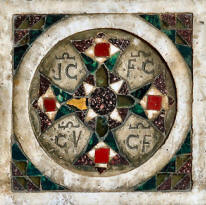|
Tuesday 7th March
My first visit to Milan, and it's an
Art Pursuits guided trip exploring Medieval Milan
with Sally Dormer from the
V&A. The big draw for me in Milan would ordinarily be the Brera, but it's not on the
itinerary as it doesn't have much that's medieval. There is a free
afternoon, though, so I'm hoping to get there, mostly to have a look at the many
Venetian paintings taken from closed churches, and such. There's also a
visit to Leonardo's Last Supper scheduled, although it's not medieval,
because it was thought that we'd mutiny if it wasnt included. But first I
have to tube it to the Hilton Garden Inn this evening and check in and
sleep.
Wednesday 8th March
On my two previous stays I've got the
bus from the hotel which serves the terminals and local hotels, but this time I caught the
tube. Why haven't I done this in the past? Beats me. The difference between
paying a fiver for the bus and nothing for the tube, because of the 60+ Oyster card
I've just acquired, was a definite prompt, but it would always have been
cheaper. I met up with Sally and John (the tour manager) at Terminal 5, no
trouble. Self check-in and even self bag-drop were achieved with little
difficulty. Security was negotiated, coffee and an almond croissant was
consumed, and another V&A course veteran was bumped into, so there were
only some flight delays to minorly spoil things. We were coached from Linate to
our hotel, the Rosa Grand, and then had time to settle in and wander out to
find some lunch. A mozzarella, tomato, basil and mayonnaise panino in my
case, followed by a coconut and lemon gelato, my first of the year.
Our first visit was to the Duomo, firstly to admire the underground
remains of the old baptistery, then the odd gothic-but-not interior, and
finally the special cast bronze Trivulzio Candelabrum in the north
transept, which is an area used for private prayer usually, but we had
special permission for a visit after 6.00. The dragon-based and
vegetation-infested lower part is 12th century and attributed to Nicolas of
Verdun, who was also responsible for the Shrine of the Magi in Cologne
Cathedral, where I was before Christmas.
Then back to our hotel, cunningly close
by, for a rest before dinner. Which was in Lo Sfizio, the hotel
restaurant, run by Eataly, and minimal and tasty. A thick dark potato soup
with goat's cheese was followed by a small pile of roasted vegetables with
a smear of sauce and crunchy salad shavings. Good red wine and tiramisu
too.
Thursday 9th March
The hotel's breakfast rooms were a
confusing warren of spaces, odd corridors and many mirrors. Good
comestibles, though, including real orange juice, fresh pineapple, small
wholemeal croissants, and slices of amaretto (biscuit) cake, a new favourite. The first visit
this morning was out to San Lorenzo Maggiore, with its impressive screen
of columns out front. The church is centrally-planned and lofty, but we
were for the 4th century mosaics in the Chapel of Sant'Aquilino (see right). A short coffee break (actually a marron
glace and almond milk gelato sitting in front of the Pinacoteca Ambrosiana for me) and them into San Satiro for the
fragmentary Carolingian wall paintings and a terracotta polychrome
Pieta. But even more impressive was the trompe l'oeil apse, the work
of Bramante so not on our syllabus.
After lunch a coach took us to Leonardo's Last Supper fresco in the
refectory of Santa Maria della Grazie. We only got 15 minutes, but it was
just about long enough to feel a bit of magic. It looked a lot less faded
than I was expecting. The guide dismisses the theory that the figure of John
the Evangelist is actually Mary Magdalene, without mentioning Dan Brown
and the damn Da Vinci Code - the source of the stupidity - but does
contribute her own by saying the figure might also by seen as the Virgin.
Then on to the Basilica of Sant'Ambrogio for its early mosaic work in the
chapel of San Vittore, the gold and silver altar surround, and its
massive, and massively confusing, ambo. Then rather a long walk back to
the hotel, with coffee and cake half way.
In the evening Sally took a bunch of us to the Osteria dei Poeti, a neighbourhood restaurant that
had been her and her husband's regular when they'd lived in Milan. The warmth of her welcome back
from the owners, Silvana and Riccardo, was matched by some imaginative and tasty
dishes. I had good bean and pasta soup followed by an artichoke, potato and
cheese bake thing, with a very special pear and chocolate tart to finish.
Down a buzzy street on the way back there were at the least four fortune
tellers set up behind tables on the pavement. Something I'd never seen even one
of before.
Friday 10th March
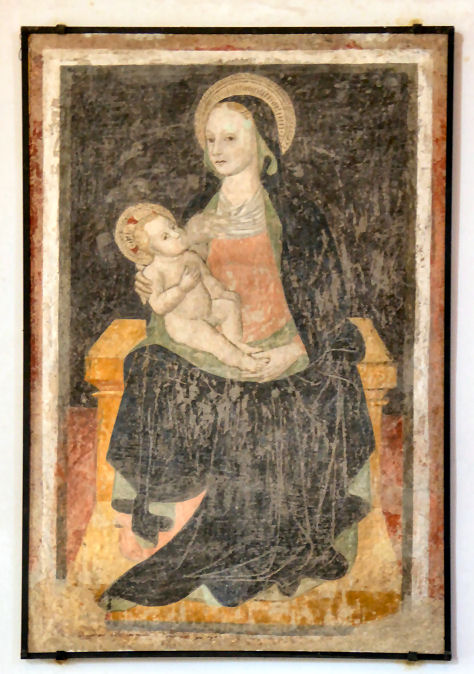
This morning we coached it to
Sant'Eustorgio, and this is where your correspondent missed his footing
getting off the coach and took a tumble. Since tripping over in both
Venice and Florence a few years back I've been as sure-footed as a young
gazelle. This time it may have been due to the changed curvature of my
varifocal sunglasses. Odd that I only ever fall over in Italy too,
suggesting a physical manifestation of Stendhal Syndrome. Anyway, we had come to see the huge tomb which had supposedly
housed and transported the Magi's relics here before they were removed by
Frederick Barbarossa and taken to Cologne, ending up in a shrine made by
Nicholas of Verdun, who I mentioned on Wednesday. Also here is the Portinari
Chapel where there is the impressive tomb of St Peter Martyr by Giovanni
di Balduccio, a pupil of Giovanni Pisano and frescoes depicting episodes
from the saint's life by Vincenzo Foppa. He is the saint usually
represented with a chopper in his head, put there by a murdering heretic,
this Peter being famous for their persecution. Then into the Museo
Diocesano next door to see a silver reliquary box from the church of San
Nazaro in Brolo, the sole remaining two carved door panels from Sant'Ambrogio and a
stucco roundel of Saint Ambrose. Having had my fill of the medieval I
stayed behind to look at the paintings upstairs, which were not all
religious, oddly enough, but included some 18th-century views of Rome and
ruins by the likes of Panini and some impressive drawings from many eras, as
well as a variety of more usual religious stuff, including a Tintoretto
Woman Taken in Adultery.
My solo stroll back was in warm sunshine and in the Duomo Piazza a place
called 12oz provided a roasted vegetable and hummus bagel and a forest
fruits and coconut smoothie, then a pistachio muffin and a cup of redbush
tea favoured with orange, vanilla and honey to take back to the hotel.
Perfetto. After lunch we visited the Duomo museum to see some ivory items
- Gospel book covers and an 8th-century sitular (holy water bucket) - and a very early metal Crucifix. In the
attached church of San Gottardo in Corte, only recently re-opened as part
of the museum itinerary, we admired the wall tomb of Azzone Visconti, who
was responsible for the building of the church and commissioning a
large Crucifixion fresco, a sizeable patch of which was recently
found as is now on the back wall of the church. It's decidedly
post-Giotto, not by the man himself, as even the museum's captioning
admits, but not without charm.
Walking back through the collection Sally and I got into informative
discussion with a refreshingly unusually knowledgeable and communicative attendant, much like happened
to me in the Diocesan museum in Venice in January. Quite an early
finish meant we had some for pre-dinner shopping and/or resting. An even more
select bunch were taken by Sally and John to the Cantina Della Vetra
tonight. And I finally got to have Milanese risotto, which is
characterised by saffron and hence yellowness. The mascarpone gelato with
pears in a spicy red wine sauce was more exciting.
Saturday 11th March
A coach took us to Monza this
morning, to the Duomo there to see the frescos of the life of Queen
Theodolinda. I'd been here to see them on
another art trip last year, and was more
than excited to be seeing them again. The museum at the Duomo has some
appealing stuff too. I headed off solo to revisit the Annunciation
fresco fragments that I liked last year. I was going to chance ignoring
the No Photo rule as I had the gallery to myself, but a nearby cctv camera
had a noisy motor which whirred whenever I moved and so made it obvious I was being tracked.
At Monza, in April 1929, I was permitted a close
scrutiny of the famous Iron Crown of Lombardy and saw also many personal
relics (hair combs etc) of Queen Theodolinda and her contemporaries. I can
still not understand the mentality which exhibits in the same room as
these genuine articles "the handbags which the Twelve Apostles carried
about Galilee".
from Ceremonial Curiosities and Queer Sights in Foreign Churches by
Edward Forse
For lunch I was happy to have been able to negotiate the making of two
fresh and caldo mozzarella and tomato rolls in a neighbourhood
bakers, for 4
with water. The gelato copetto to follow combined mandarin/almond
with coconut flavours. The coach returned us to the hotel and a free afternoon.
A fair
few of us decided to do the Brera, me to find the paintings taken from
Venetian churches, mostly, but also some new names, some impressive Crivellis and how truly huge the
famous Bellini Saint Mark Preaching in
Alexandria is.
Our final group meal was at the Al Mercante and was sorely disappointing
after the run of impressive and imaginative vegetarian options
thus far. I was initially offered the tedious old standby of roasted
vegetables and told that was the only veggie main course option, but John
negotiated some spaghetti in a tomato sauce - not wildly original, but
better. And the desert was a just few strawberries, sliced and topped with
nothing. Oh
well, not all meals can be special, and most have been on this trip.
Sunday 12th March
After checking out and leaving our
cases at the hotel we made for the Archaeological Museum for our final
visit. Two ancient items, a silver plate (the Parabiago Patera) and a
Roman glass goblet of spectacularly complex construction, were analysed and admired, as
were the recently exposed damaged frescoes of saints in niches and a Crucifix
in a defensive tower on the old walls (see above right). Then we broke for
lunch and I discovered the frescoes in the church of San Maurizio next
door (see right), to which the overwhelming reaction was 'wow!' They
are mostly the work of Bernardino Luini, but a fair few others too,
including his sons. The church is divided into two by a
tall screen, with the choir behind reserved for the nuns, so there are
basically two huge spaces full of painting. And cunningly some of the
saints facing the main body have their mirror images behind. This
screen is where most of the work of Bernardino himself is to be found.
Walking back to the hotel I heard my name called from outside a restaurant
and so got to join Sally and two of our number for a light spaghetti lunch. And
in no time we were coached to Linate airport, negotiating the confusing
route to departures, checking in, eating a last gelato - a nocciola and
mango from Venchi - and sitting and waiting. Our flight was even early, so
I was soon met by Jane, on the tube and home to our remaining cat, who
seemed to have missed me. |
|

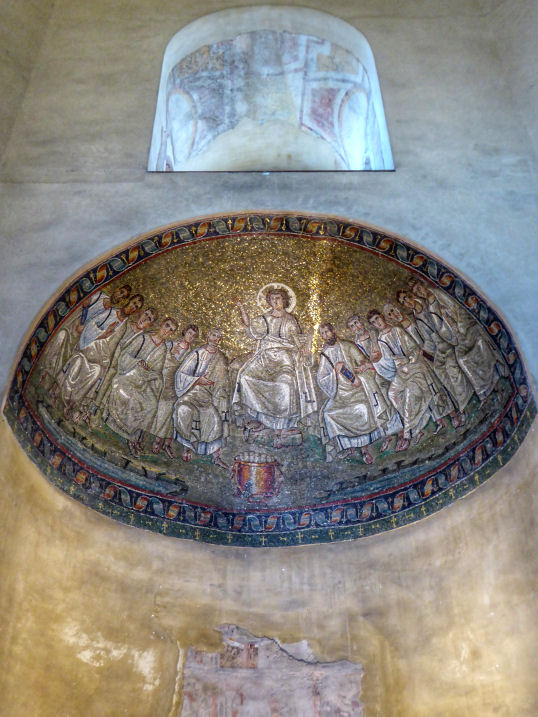
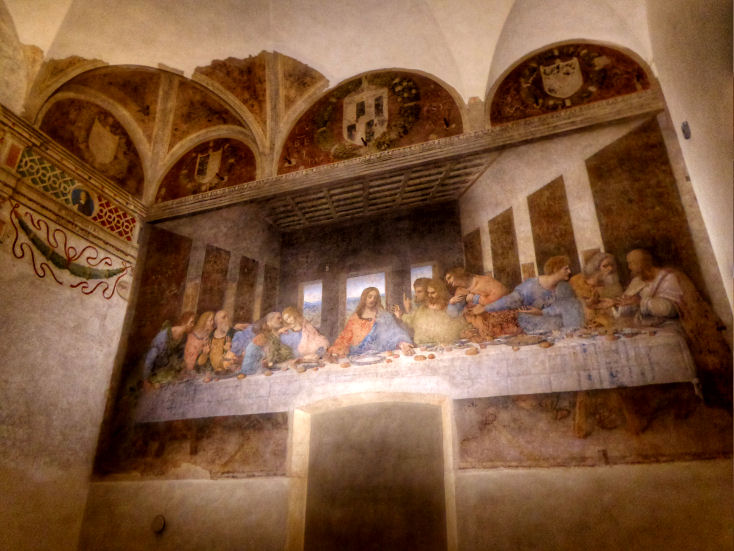
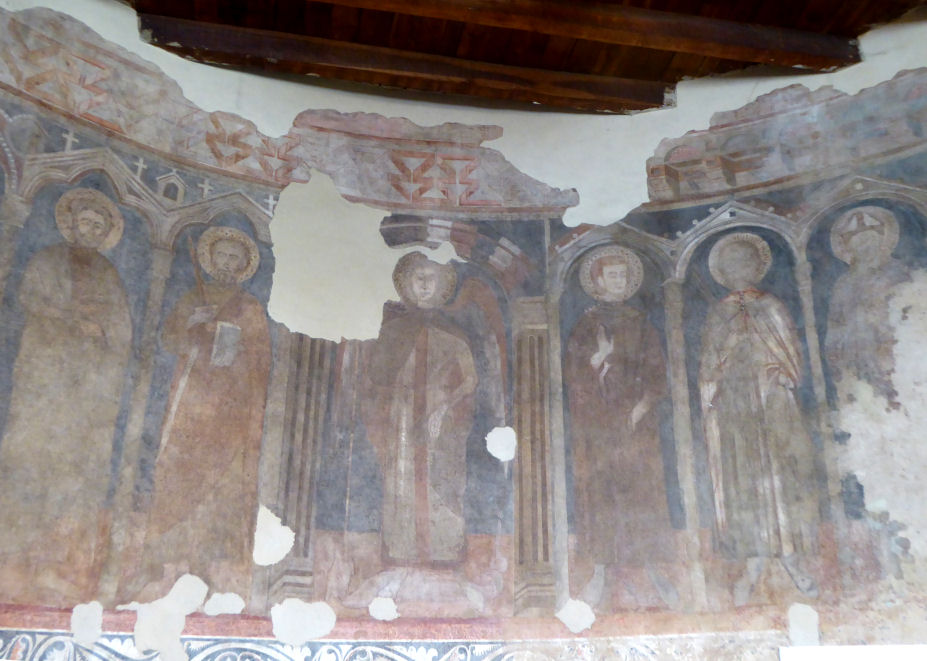
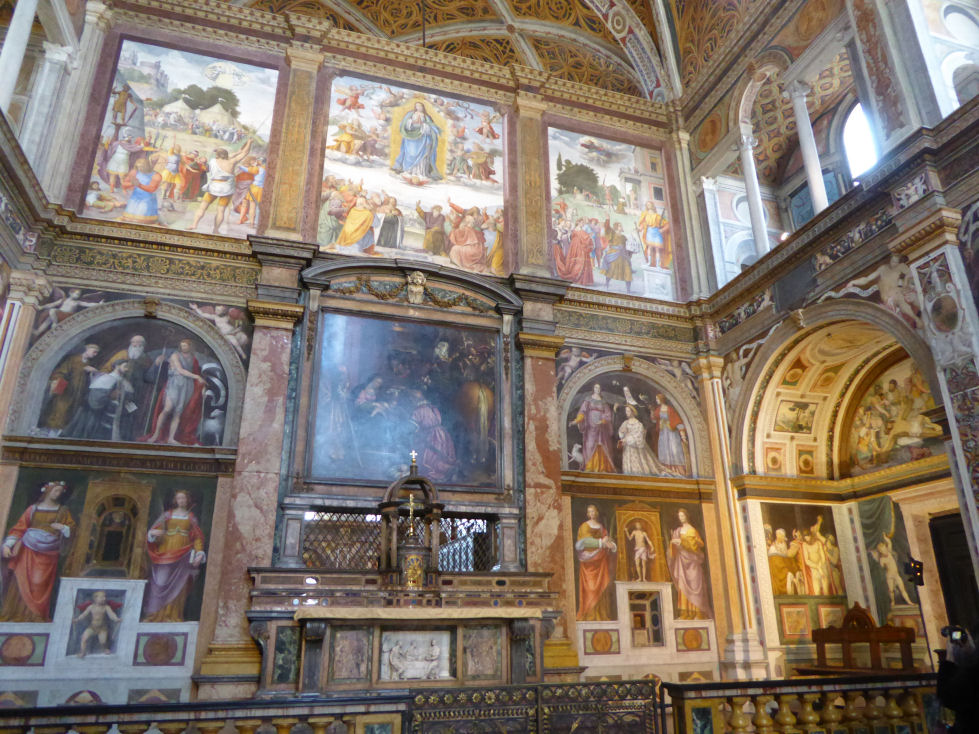 |
